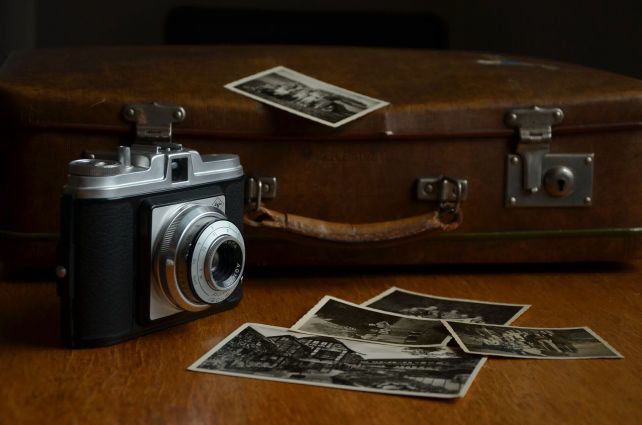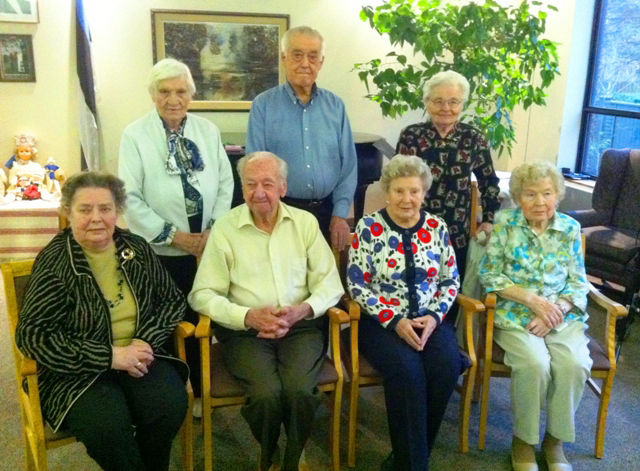
Guri & Marcella Raag
Passenger Stories

Passenger Stories
Guri and Marcella Raag's Journey About the Refugee Ship Walnut From Sweden to Canada Nov. 17 - Dec. 13, 1948
Translated by Tiiu Roiser with permission - 2013 (Read original in Estonian)
My name is Güri Raag.
Together with my wife Marcella, after departing my homeland in 1944, I lived through a "new escape" from Sweden to Canada aboard the 350 ton steamship the Walnut. This ship was a WWII minesweeper meant for 60 men. The ship was purchased by a group to which belonged A. Kalbus, H. Suursööt, the ship's Captain A. Linde, and others. The cost of passage was $250 US per adult and $150 per child. Shares of the ship could be purchased for $1000 Swedish krona.
About 350 passengers were gathered, all of whom knew that there were no conveniences on board. Sanitation was limited, not to mention the limited organization of preparing food, and so on. Three level bunk beds had been built for sleeping. You were responsible for your own mattress and linens.
To answer the question of why this kind of voyage when there were opportunities to travel with large, comfortable ships? The reasons are as follows:
1. Traveling on a passenger ship required that one have a Visa, immigration papers and $2000 US or a one-year work contract. The Canadian government was not conducive to immigration at that time.
2. Two years prior to the Walnut voyage, Sweden had returned to the Soviet Union 167 Baltic soldiers, amongst whom were many Estonians. In our group there were many previous soldiers and the fear was that their fate would be the same.
3. The majority of Baltic refugees arriving in Sweden in 1944, including Estonians, were officially registered as citizens of the Soviet Union. This could have become dangerous if the Soviet Union started to demand their citizens back.
These reasons were enough to justify our leaving, so in addition to the Walnut, there were many larger and smaller boats with Baltic peoples leaving Sweden destined for Canada or the USA.
The day before our ship's departure, Sweden's ship inspector announced that 49 individuals must leave the ship since there weren't enough life preservers. The passengers agreed amongst themselves and 49 people "disappeared" having actually hidden themselves in the ship. Permission to depart was given.
Many Lysekil residents [the town in Sweden from where the ship sailed] and passenger friends, relatives and acquaintances came to watch the Walnut's departure on November 17th, 1948. After sailing past Sweden's water border, the 49 people appeared and joined the rest of us to make 352 people on board.
The North Sea was not calm and kind toward the Walnut. At first the sea was calm and the sun was shining. The picture changed completely over night. In the middle of the North Sea we saw wave swells of 9-10 with the waves continuously hitting the decks. The storm carried away 20 tons of coal, the pumps did not work, the radio was not functioning, etc.
The wind calmed as we reached Ireland and we unexpectedly stopped in the small seaport town of Sligo. Here, repairs were made to the ship and we purchased coal and food supplies. The passengers were allowed off the ship and we were allowed showers in the local hotel and in people's homes. We stayed in Sligo for three days. My wife and I, along with another couple, were invited to the home of an Irish lawyer, where we were able to bathe, eat well, and enjoy other luxuries. They also took us to a local school, where the students had already heard about us. The children knew where Estonia was, our capital, etc.
Before leaving the port, the local Catholic priest blessed the ship and the passengers. We and those saying farewell, both had tears in our eyes.
In the beginning of December, in the middle of the Atlantic ocean, we had 10-12 ocean swells and it snowed. Most of the passengers were sea-sick, including the cook. There were many more miles to the Canadian border. Our destination port was Halifax, but we had to turn into Sydney in order to take on more coal. We had used up almost our last piece coming across the stormy sea. We were provided free coal from the Canadian government.
In Sydney, were were brought gifts, treats, articles of clothing and other essentials.
A small boat guided us through narrow islands and we arrived in Halifax on December 13th. Our arrival was not a surprise. The local radio announced the arrival of the "Vikings" and the papers wrote of our journey. In Halifax, some of us were housed in immigration rooms while most were taken to the former army hospital outside of the city in Rockhead. Single people were housed in large rooms, while couples were given their own rooms.
Our social and community activities began immediately. We held meetings and began to learn to speak English from teachers within our group. We established a choir and prepared for Christmas and the New Year.
The Red Cross visited us on Christmas Eve. They brought gifts, and treats and toys for the children - all wrapped in beautiful Christmas paper. We sang, danced, ate treats and were very happy.
On New Year's Eve there was a masked party, where particularly noticeable were the costumes of Hitler (with the swastika) and Stalin (with his moustache).
One day in January, the mixed choir was invited to a Lutheran church in Halifax, where, under my direction, to a full church, we sang two songs: Schubert's "Holy, Holy, Holy" and Beethoven's "All the Sky's Sing". Later, we were seated at a coffee social with the Church's choir and congregation members.
The Halifax papers wrote about us often. They presented the stories of passengers and our suffering under the communist regime. All Walnut passengers mentioned that arriving in Halifax was their happiest of days.
Immigration officials interviewed us in Halifax.
One interview occurred in an unusual fashion. One official invited our ship's doctor and my wife and I to his home. He offered us drinks and dinner. The immigration official was interested as to why we left Sweden, about life under the Communist regime, etc. The interview was conducted in English, which we all knew a little. After coffee, our host called for a taxi to take us back. Our trip took us past the jail. We were very nervous and expected that the taxi would be taking us to the jail. This, of course, did not happen and soon we were back "home" in Rockhead and felt secure.
After the interviews, all except two passengers were accepted to Canada and job offerings began. Most of us wished to settle in Toronto. Our wishes were granted and in February of 1949 we went by train to Ajax, a city near Toronto. Here we were housed in university apartments. Jobs were assigned, but we could also find our own jobs. Soon, all the passengers had left and everyone started their lives on their own, in their new country, Canada.
Guri Raag - Toronto 2003

Walnut passengers gather at Ehatare retirement home in November 2013, to celebrate 65 years in Canada.
Guri and Marcella Raag are seated in the front row in the middle.
Are you a Walnut passenger? A family member? Would you like to share your story? Please contact us, we'd love to add your memories to our collection.